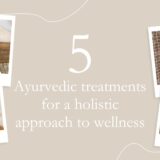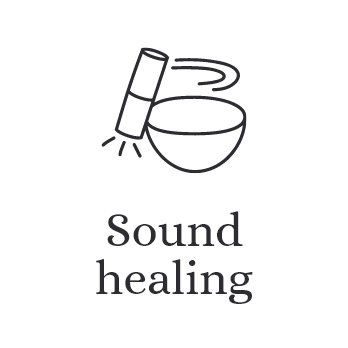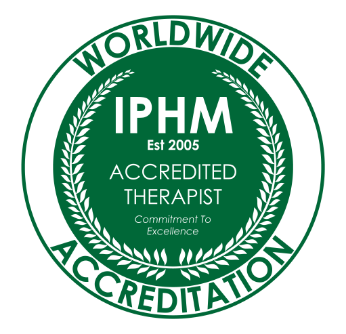The surprising link between Dental Wellness and whole-body health
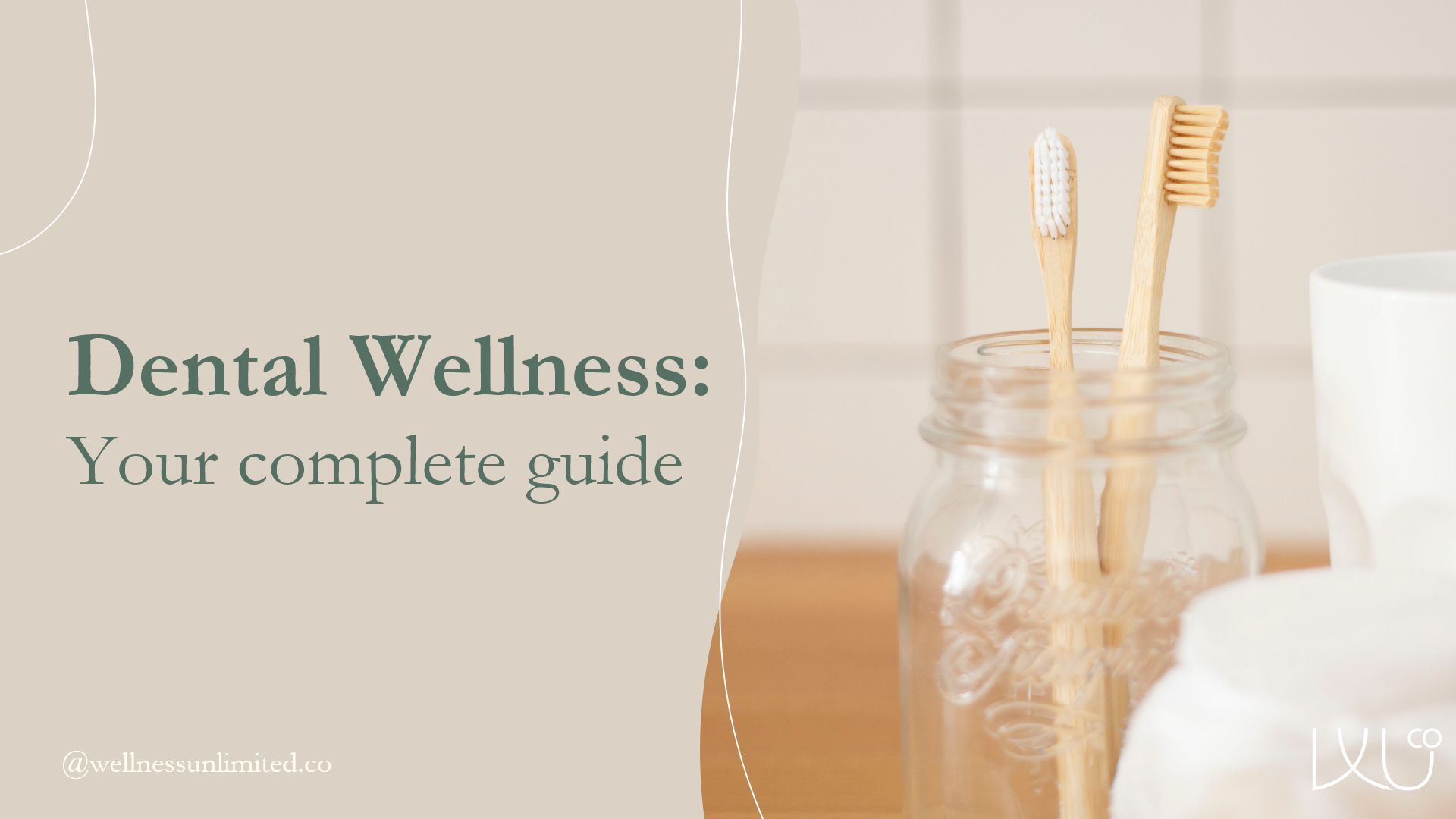
What is dental wellness and biomimetic dentistry?
Wellness is a concept that encompasses all aspects of health, including physical, mental, and emotional well-being. It’s about taking a proactive approach to maintaining good health, rather than waiting until a problem arises; this means active prevention, detecting the earliest signs of issues, and reversing them before they ever become serious.
Dental wellness
When it comes to dental wellness, you want to be health-oriented and take steps towards achieving the healthiest teeth, gums, and natural smile possible.
By adopting healthy habits such as brushing and flossing regularly, having dental check-ups, and maintaining a healthy diet – yes diet matters here! – you can prevent many dental problems before they arise. This also means choosing the most minimally invasive treatments, known as biomimetic dentistry.
Biomimetic dentistry
Biomimetic dentistry is a type of minimally invasive dentistry that aims to restore the tooth to its natural state, rather than replacing it. It uses materials that closely mimic the mechanical properties of natural dentin and enamel.Teeth are complex and enamel can heal itself, given the right conditions of course! In biomimetic dentistry, materials are added to the tooth in a way that mimics its natural structure and function – there is minimal drilling needed.
Examples of Biomimetic dentistry procedures:
- Composite bonding: Adding composite resin material to a tooth to replace lost enamel. The resin is carefully matched to the colour and texture of the tooth, and is bonded to it using a special adhesive.
- Mini sealants: after removing decayed tooth material, the surface is sealed with a liquid resin which then seals the structure. In this way biomimetic dentists work to treat and preserve the tooth that you still have. Instead of drilling out a crack in a tooth, they’ll cover it with a protective onlay or directly place composite material to protect it from further damage and decay.
Dental wellness and biomimetic dentistry go hand in hand, as they both focus on maintaining the health of your teeth and gums, while minimising invasive and harmful procedures.
Dental wellness matters to your overall wellness!
Infections in the mouth can transfer to other parts of the body. The harmful bacteria are able to enter the bloodstream, causing infection or inflammation in other parts of our body therefore leading to a myriad of health issues.
Let’s look at an actual example: Gum disease
Gum disease harms the gums and teeth-supporting bones. Neglecting it can severely harm your teeth and surrounding tissues. Gingivitis – the early stage – is the presence of inflammation in the mouth tissues and is still reversible through proper treatment, such as oral hygiene habits improvement and professional cleaning. If left untreated, it can progress to periodontitis, which is gum disease, harming the bones and tissues supporting the teeth, leading to tooth loss and impacting oral health.
Now what has gum disease to do with overall wellness?
Gum disease is a form of chronic inflammation that occurs as a result of periodontitis causing bacteria within the gums. These harmful bacteria can be released into the body, which can increase the risk of developing a handful of health conditions, including heart disease, stroke, and diabetes.
By maintaining healthy gums and teeth, you automatically reduce the risk of developing health issues.
When we know that inflammation is the root cause of most (if not all!) chronic diseases we want to keep inflammation at bay and do what we can to prevent it from being there in the first place.
Did you know that…
…staying on top of your dental health can also help reduce your dental and medical bills!
Optimal oral health: what to consider
When evaluating your dental health, a holistic view is the best way to go. This takes into account the many different factors and potential risk areas (which can lead to issues in other areas and health deterioration).
The 3 main areas to consider are:
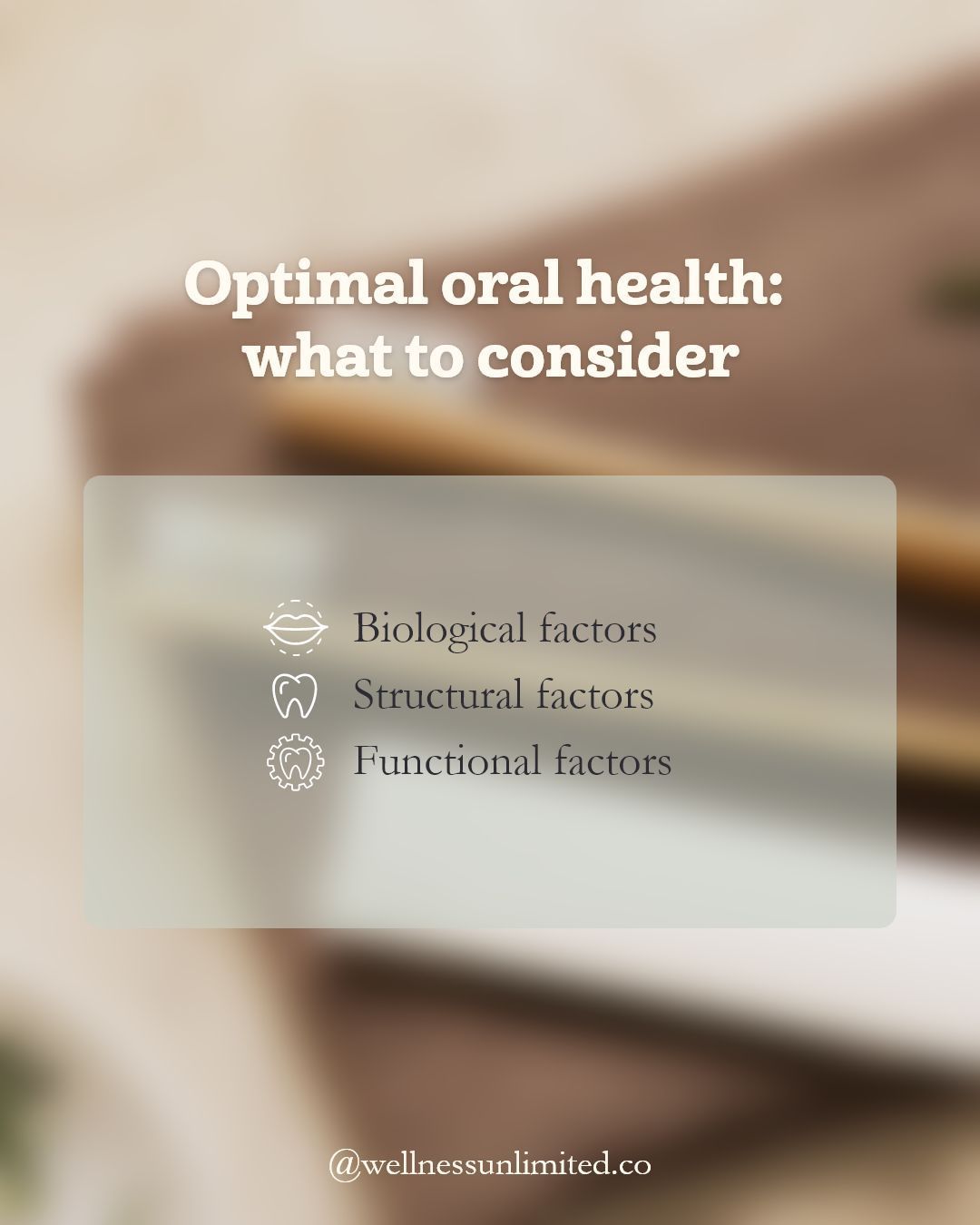
1. Biological factors:
Refer to the health of your gums, teeth, and jawbone, and how they are affected by genetics, lifestyle habits, and other health conditions. Examples:
- Teeth colour: provides information about your enamel health since thinner enamel appears more yellow and can indicate damage from dietary acids or health conditions;
- Gums: inflamed gums can lead to sensitivity, gum recession and loose teeth.
2. Structural factors:
Relate to the shape, position, and alignment of your teeth, and how they are affected by dental conditions such as cavities, fractures, or wear and tear. Let’s look at a few examples:
- Enamel & tooth edges: enamel erosion can lead to chipping and sensitivity;
- Crooked teeth make it harder to clean effectively, promoting harmful bacteria. Check Straight Teeth Direct for convenient and invisible adult orthodontics powered by a teledentistry platform.
- Tooth shape (triangular, rectangular or square) can affect your tooth health in different ways.
3. Functional factors:
Refer to how your teeth work together to bite, chew, and speak, and how they are affected by issues such as tooth loss, or bite problems. For instance:
- Biting surfaces: food and bacteria can accumulate on back teeth biting surfaces and between teeth, leading to cavities, toothache, and root canal;
- Teeth grinding & clenching: can cause chipping or even splitting of teeth if not prevented.
By considering these three main areas of dental health, you can work with your dentist to develop a personalised plan that addresses your specific needs and helps you achieve and maintain a healthy smile for years to come.
Get an advanced dental risk assessment from a dentist across 22 data points, understand your unique risk factors and get advice on preventative procedures and regimes to achieve optimal dental wellness.
Best oral care practices
There is no magic key to unlocking your healthiest smile. However, establishing a solid oral care regime to support your gums, enamel, and dental health will certainly go a long way.
What to do
1. Eat & drink consciously
That means avoiding sugary foods and drinks that can cause tooth decay and acidic or carbonated drinks that dissolve enamel making it more prone to chipping.
Find out why drinking plain warm water and eating the rainbow are great wellness practices to incorporate into your daily routine.
2. Create a solid oral hygiene routine
Using an electric toothbrush and a fluoride toothpaste can help you better prevent tooth decay.
3. Clean the hidden areas (40% that your toothbrush can’t reach)
The surfaces between teeth are important to clean as food gets stuck there and can lead to decay. This can be done either with small interproximal brushes, regular dental floss or a water flosser with a mix of water and medicated mouthwash – this can help prevent gum disease, a common cause for inflammation.
4. Scrape your tongue first thing in the morning
According to Ayurveda, this helps remove toxins accumulated on the tongue overnight and unwanted bacteria that cause bad breath.
5. Visit a dentist every 6 months
Pre schedule your bi annual appointments with your local dentist for professional hygiene and overall check up. Make sure to schedule a date for the next appointment each time.
Toothful advice!
- When drinking anything sugary, acidic or carbonated use a straw (reusable of course!) to stop the liquid from touching your tooth surfaces;
- Change your toothbrush head every 3 months.
Bad dental habits: what to avoid
1. Spitting your toothpaste after brushing
Instead of rinsing your mouth after brushing, spit out the excess toothpaste so you can give it more time for the active ingredients to strengthen your tooth enamel.
2. Brushing straight after eating acidic foods or drinks
When you eat, the acidity levels in your mouth increase as your teeth come into contact with foods and drinks. This acidity weakens enamel, making your teeth susceptible to damage from brushing. Wait at least 1 hour after eating to allow your mouth to return to a more neutral pH level.
3. Over Brushing your teeth
Over brushing can harm your teeth and gums. Particularly when done with a hard-bristled toothbrush or an aggressive brushing technique, can damage your enamel and gums, leading to gum recession. Brushing twice a day for two minutes each time is sufficient for most people, but be sure to check with your dentist!
4. Abrasive whitening toothpastes
Abrasive whitening toothpastes other over the counter natural whitening products can damage your tooth enamel over time. Even though results may seem immediate, it will gradually wear down your enamel, leaving your teeth vulnerable to sensitivity. If you want a whiter smile make sure to opt for a clinic grade whitening treatment under the guidance of your dentist – follow this link for a dentist prescribed internal whitening solution.
5 practical tips for achieving optimal dental wellness
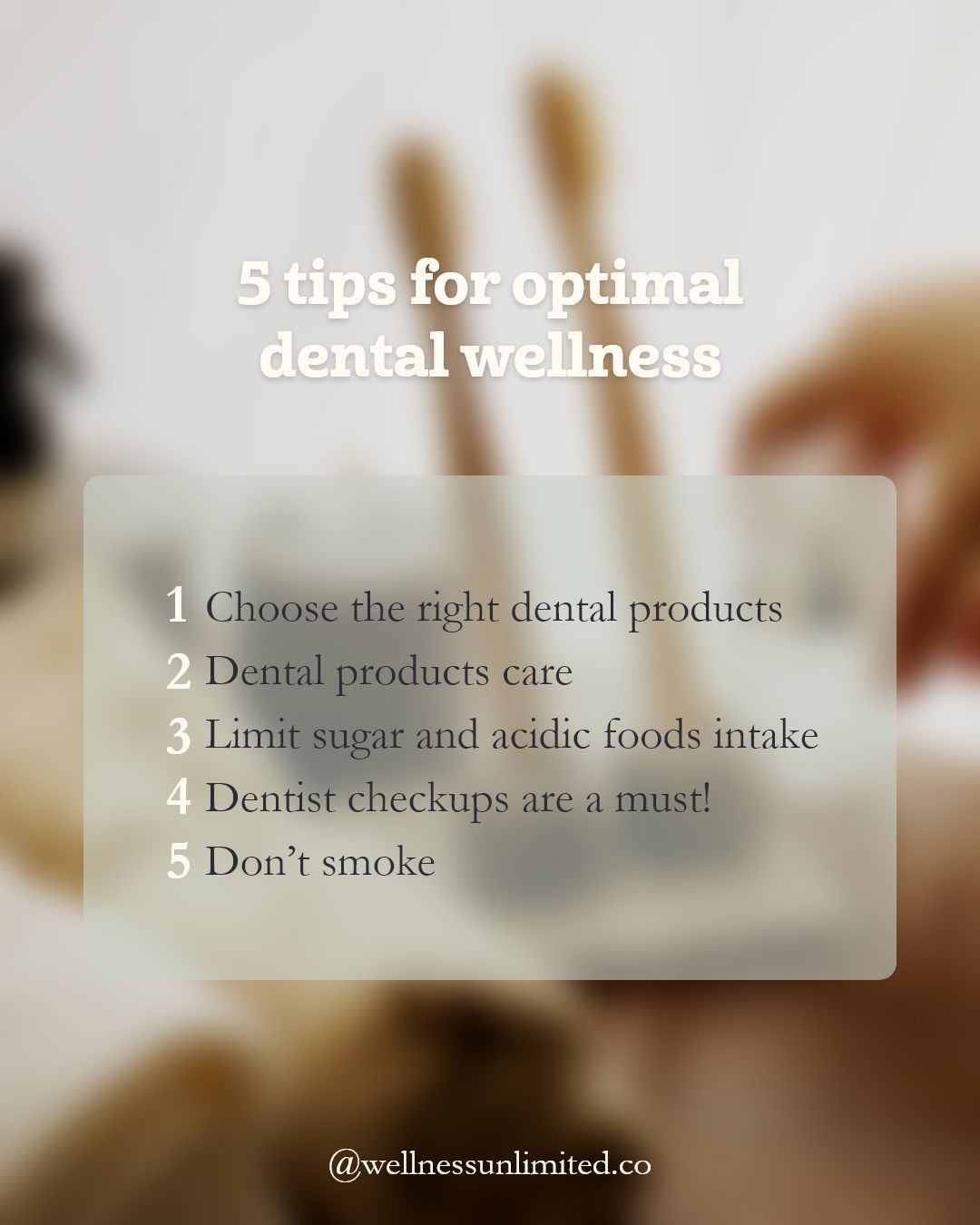
Here are 5 practical tips to keep in mind when aiming for optimal dental wellness:
- Choose the right dental products: in order to maintain good oral hygiene, it is important to use the appropriate dental care products. A good toothpaste, waterflosser, tongue scraper, and ultrasonic toothbrush like the sustainable Suri toothbrush are among my top must-have products! Make sure the products you choose are best suited to your own individual needs.
- Dental products care: always store your dental products in a dry place, upright to ensure they dry off, and clean them regularly. Pro tip: for this you can use an ultrasonic cleaner! This keeps dental appliances and products free from harmful bacteria. The Suri toothbrush comes with a really cool UV case that kills 99.9% of harmful bacteria accumulated on your brush in just a minute. This on top of changing the brush heads every three to four months ensures sanitary and effective dental products.
- Limit sugar and acidic foods intake: this can wear down your tooth enamel and lead to decay. Ttips: use a straw and drink plenty of water to help wash away harmful particles after sugary or acidic foods and drinks.
- Dentist checkups are a must! Even if you call yourself a master of dental wellness at home, it’s imperative that you see your dentist for regular checkups and cleanings.
- Don’t smoke: It stains your teeth, causes bad breath, increases your risk of developing gum disease and oral cancer. If you’re a smoker, consider quitting. This will most definitely improve your dental and overall health.


